Are you ready to be mesmerised by the most beautiful Pothos variety you ever did see?
Meet the Manjula Pothos – a brand-new plant that has only been on the scene since 2010! I know a plant mother really shouldn’t have her favourites, but quite frankly, my baby Manjula is currently occupying the #1 spot.
With stunning marbled and blotched patterns and white variegation, it looks like the love child of the Marble Queen and N-Joy.
And, boy does this stunner put the jewel in Manjula.
It also goes by it’s scientific name, Epipremnum aureum Manjula, Happy Leaf Pothos, HANSOTI14 (named after the guy that made it!), and Devil’s Ivy – just to be extra.
Adorned with a mixture of dark greens and light greens, with delightful white streaks and the most perfect heart-shaped leaves – this plant is breathtaking addition to any home or terrarium.
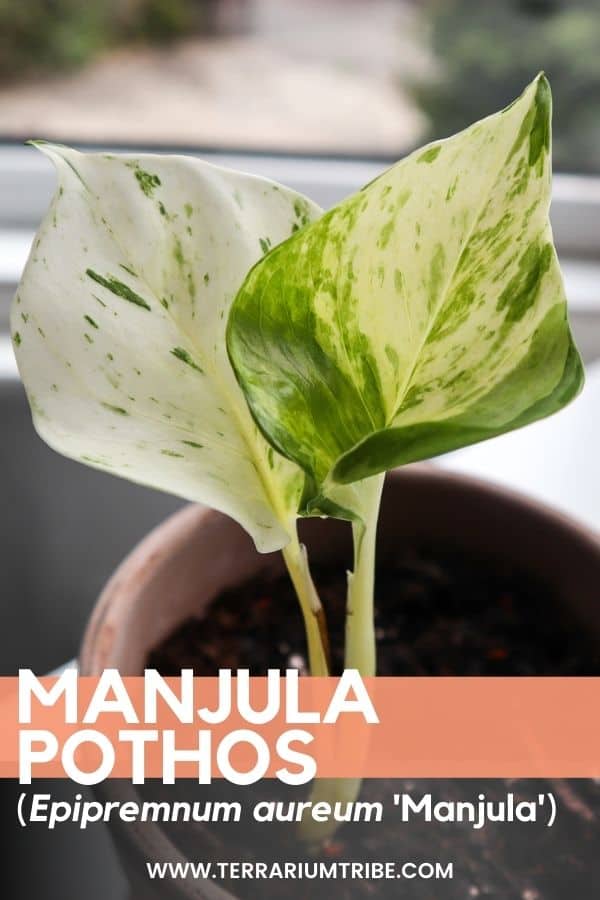
The Real Scoop on the Manjula Pothos
The gorgeous Manjula Pothos is a patented variety of Epipremnum originating from India, and is often incorrectly identified as a Floridian (perhaps is confused with the aesthetically similar Pearls and Jade Pothos, which was created by the University of Florida).
And yes, I have a headache from hours of deep-diving into patents and university records to get to the bottom of it.
This new kid in town was created via naturally occurring branch mutations over several years of selecting from a group of over 1000 plants, with a selection criteria of shorter internodes and brightest variegation.
Basically, its creator, Hansoti, kept going until he had developed the most stunning, highly variegated plant in the entire world.
And he succeeded.
Luckily for us, this has left us with a beautiful houseplant (and possibly the most terrarium-appropriate Pothos you can get your hands on, thanks to its unique growth pattern).
Where to Find the Manjula Pothos For Sale
See the links below to purchase from reputable terrarium plant shops and marketplaces (may include affiliate links).
Manjula Pothos Care & Growth
At a Glance
| Plant Type | Vine, foliage |
| Lighting | Bright indirect light |
| Temperature | 50-95°F (10-35°C) |
| Watering | Moderate, even moisture |
| Humidity | Moderate to high humidity (60-90%) |
| Growth | 1ft+ Semi-vining |
Manjula Pothos Light
The Manjula Pothos can thankfully survive in most light conditions, so fear not ye with an awkward window!
But, as is typical with tropical vines, indirect light over direct sunlight is preferable. This plant can really take the heat, but direct light can scorch the leaves – so make sure it’s not in the blazing sun.
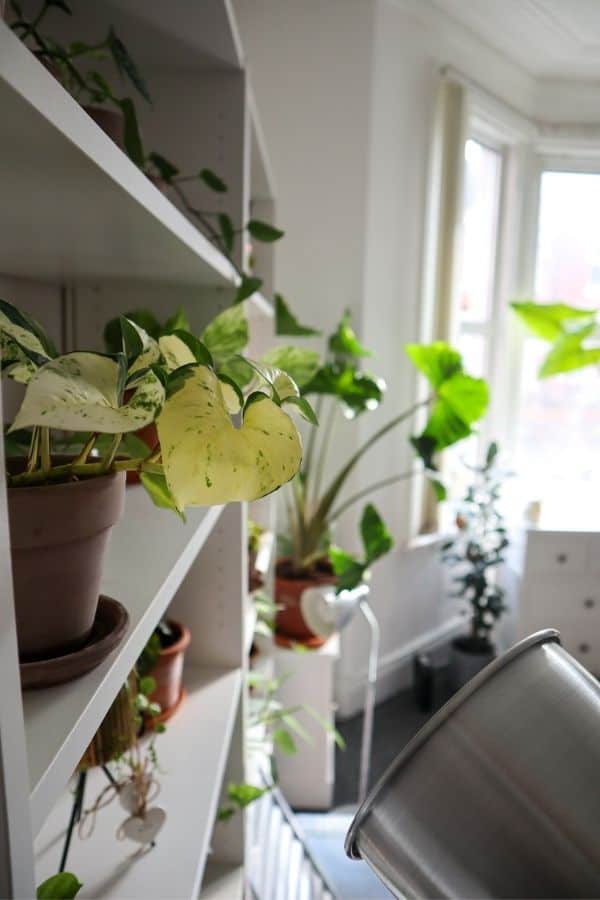
With that being said, because of the white leaves, the plant needs more bright light to photosynthesize than other Pothos varieties – making indirect but very bright light the goal.
In the dim light, your variegated leaves might lose some of the yummy creamy-white color. You can always pop it beneath a grow light if you’re unable to provide it with enough natural light (we do exactly that in Winter – hence the lamp in the photo).
Watering
To keep your Happy leaf happy (I’m sorry) make sure you keep your pot a strictly no soggy soil zone.
As a houseplant, the easiest way to do this is by making sure you plant it in a pot that has a drainage hole. That way, any excess water will flow out the bottom and keep your plant root rot free.
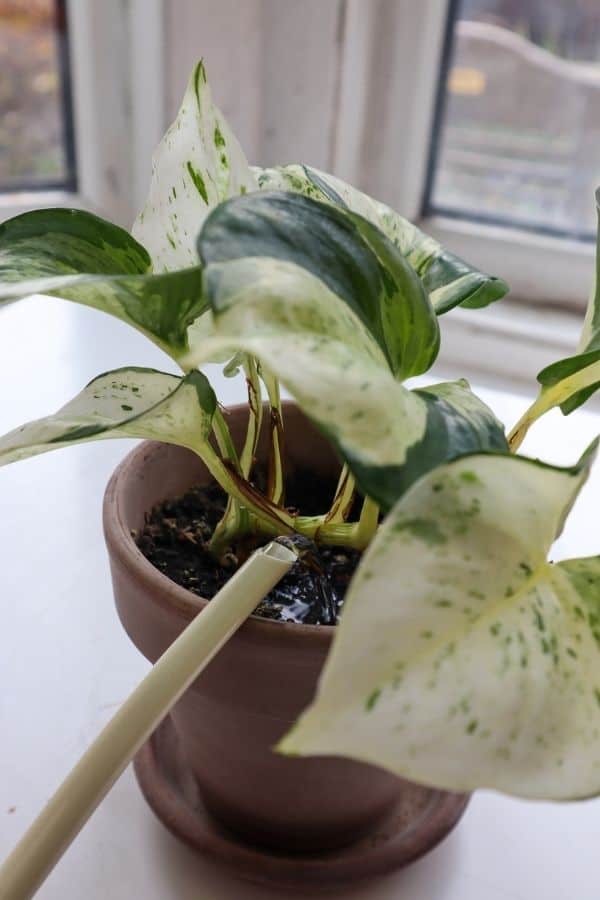
This particular variety of Pothos isn’t particularly drought tolerant, so I’d be careful not to keep it in dry soil for too long.
Water regularly and evenly when the soil feels less moist to the touch (testing it with your finger).
In a terrarium, you can make sure the Manjula Pothos doesn’t rot by using a drainage layer before your substrate – I like to use Leca. You can make sure your plant has enough even moisture by getting the right substrate mix.
Substrate / Soil
With this particular plant, use a substrate with excellent drainage yet fantastic water retention. This will ensure your Pothos has access to moisture, but won’t be sat in excess water.
And, getting a good quality mix is vital to the longevity of a terrarium!
So, whether as a houseplant or a terrarium build, I’d recommend a mix high in coco coir, orchid bark, and pumice or vermiculite. This will also give your lovely plant/s plenty of root aeration (yay).
👉 Our premium tropical substrate is a great all-rounder.
Temperature & Humidity
I’ve not yet come across a tropical plant that is so temperature tolerant as the Manjula Pothos.
She has been recorded able to withstand low temperatures to 43°F (6°C) without damage and temperatures as high as 104°F (40°C) with shade.
While she can tolerate both ends of the scale (in the same way that a cat might tolerate its humans), I wouldn’t expect her to necessarily thrive at either end.
But, she should be perfectly happy anywhere in the region of 50-95°F (10-35°C), which is pretty doable, right?
Like the whole Pothos family of plants, the Manjula loves high humidity, so if you were looking for any more persuasion to pop it in a terrarium, here you have it.
As the Manjula Pothos has been primarily grown in Mumbai and Florida, you can expect her to enjoy anything in the 60-90% range.
The higher the humidity, the more likely you might see aerial roots developing, too – how exciting!
Growth
This lovely is quite the black sheep of the family when it comes to growth rate. While most Epipremnum aureum varieties boast faster growth and will easily take over your house in 5 minutes flat, the Manjula Pothos likes to take her time.
The Manjula also has more of a mounding growth pattern compared to other Pothos (meaning she’ll grow both horizontally and vertically), so you can expect denser growth and less legginess, especially in infancy.
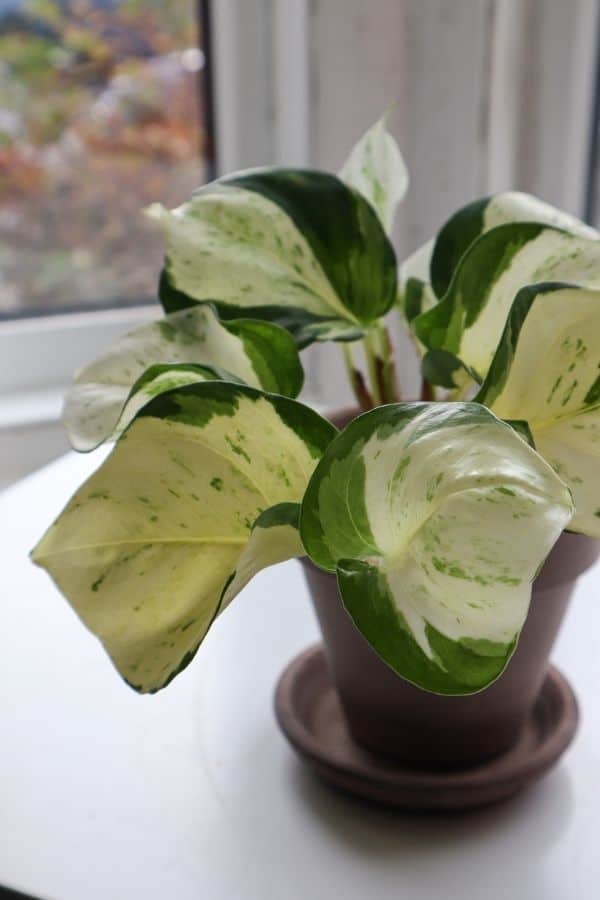
The distance between each leaf node is shorter than with other Pothos types, too, each up to an inch in length. So, you’ll get a much fuller-looking plant than your average Pothos.
And, not to mention another striking feature of this variegated darling – the wonderful wavy leaves, which really stand out next to my other Pothos varieties that have much flatter leaves.
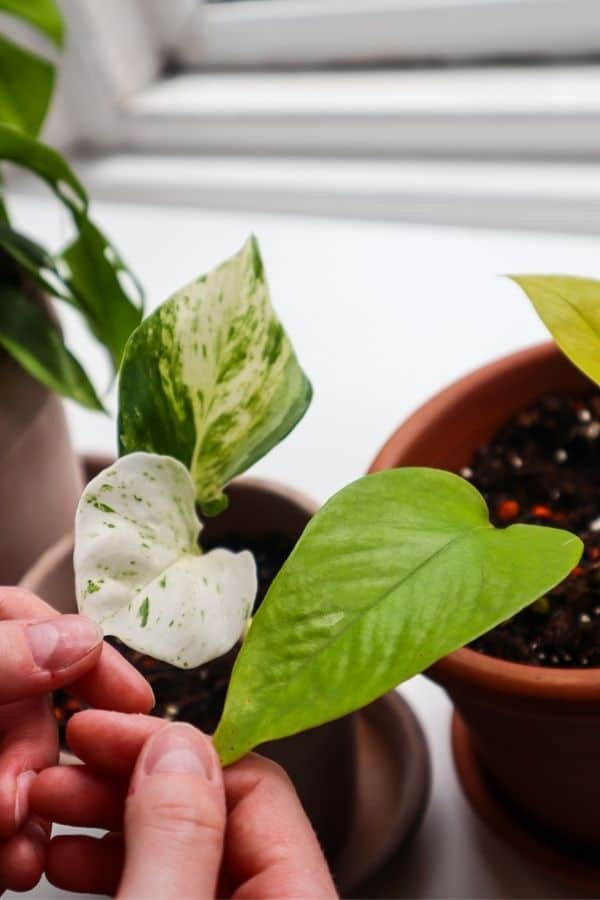
For these reasons, I think the Manjula Pothos looks best when maintained as a gorgeous bushier plant with dense foliage as opposed to having it as a trailing or climbing plant.
With that being said, more mature plants will have a trailing growth pattern, so she will look great climbing a moss pole or dangling from a high shelf, too, if that’s how you want to show her off.
Being a slower, steadier grower, the Manjula is definitely best suited for a terrarium out of all of the Pothos plants. Like all plants that inevitably grow, she’ll need the occasional trim (obviously), but overall, she will need much less maintenance in comparison to her cousins.
And, is there anything more dazzling to pop in a terrarium than that that signature splash of white?
How to Propagate the Manjula Pothos
The Manjula Pothos will propagate very easily via stem cutting.
Just take your scissors and snip beneath the root node, then stick it in a jar of water, and you’ll have roots forming shortly. It’s that simple – hurrah!
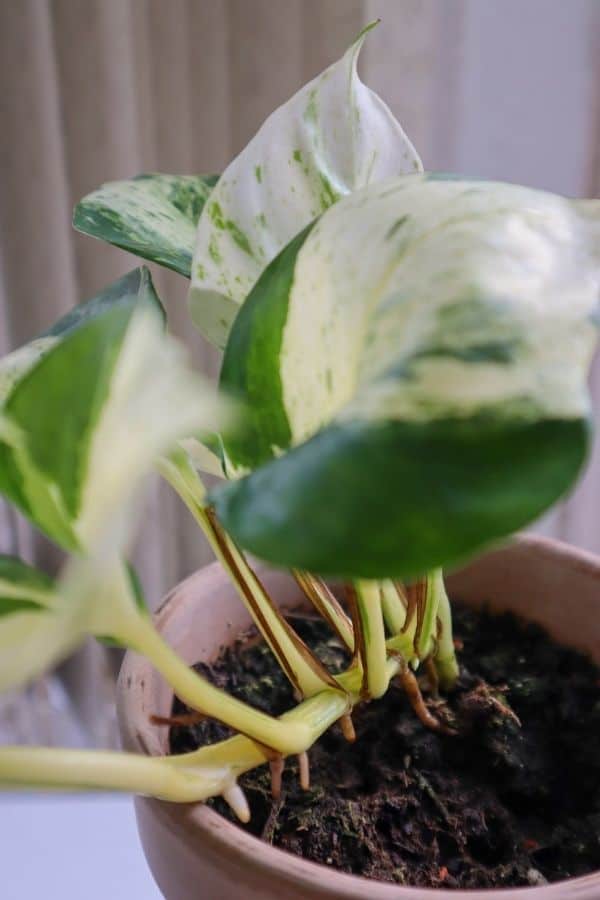
Expect it to take around 20 days in the summer months and up to 40 in the winter months (or if you live in a colder climate).
When the roots are nicely established – plant it up, give it a name, marvel at your new plant baby, and take it to a plant swap to lure in new friends.
Varieties & Similar Plants
As a self-identified Pothos fanatic, I currently sport quite the collection – and I certainly don’t plan on stopping any time soon. There are so many beautiful Pothos plants available to purchase; here are some of my top pics:
Jade Pothos, Neon Pothos, Golden Pothos, Marble Queen Pothos, Pearls and Jade Pothos (which looks extremely similar), Jessenia Pothos, N-Joy Pothos, Cebu Blue Pothos (which is an Epipremnum pinnatum not aureum), Satin Pothos aka Silver Pothos (which is a Scindapsus).
Gotta catch ’em all!
Check out our Epic Guide to Pothos Varieties to see these in full.
Frequently Asked Questions
Your Manjula is probably not getting enough light and needs more green leaves to photosynthesize! Try moving it into a brighter spot or pop it under a grow light.
Typically yellow leaves are a sign of root rot, though it could be a few different things. Make sure you have a pot with drainage/ a terrarium with a drainage layer, and don’t let it sit in wet soil. Let it dry a little between waterings.
Sadly, as an aroid, this plant is toxic to both furry pets and people – all the more reason to put it in a terrarium if you have little paws or feet running about.
